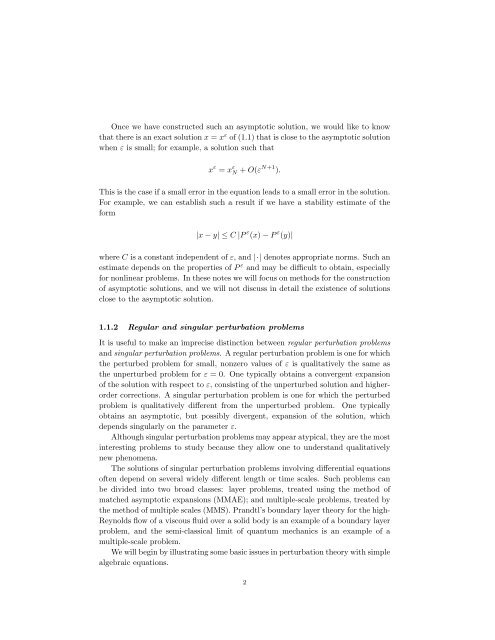Asymptotic Analysis and Singular Perturbation Theory
Asymptotic Analysis and Singular Perturbation Theory
Asymptotic Analysis and Singular Perturbation Theory
Create successful ePaper yourself
Turn your PDF publications into a flip-book with our unique Google optimized e-Paper software.
Once we have constructed such an asymptotic solution, we would like to know<br />
that there is an exact solution x = x ε of (1.1) that is close to the asymptotic solution<br />
when ε is small; for example, a solution such that<br />
x ε = x ε N + O(ε N+1 ).<br />
This is the case if a small error in the equation leads to a small error in the solution.<br />
For example, we can establish such a result if we have a stability estimate of the<br />
form<br />
|x − y| ≤ C |P ε (x) − P ε (y)|<br />
where C is a constant independent of ε, <strong>and</strong> |·| denotes appropriate norms. Such an<br />
estimate depends on the properties of P ε <strong>and</strong> may be difficult to obtain, especially<br />
for nonlinear problems. In these notes we will focus on methods for the construction<br />
of asymptotic solutions, <strong>and</strong> we will not discuss in detail the existence of solutions<br />
close to the asymptotic solution.<br />
1.1.2 Regular <strong>and</strong> singular perturbation problems<br />
It is useful to make an imprecise distinction between regular perturbation problems<br />
<strong>and</strong> singular perturbation problems. A regular perturbation problem is one for which<br />
the perturbed problem for small, nonzero values of ε is qualitatively the same as<br />
the unperturbed problem for ε = 0. One typically obtains a convergent expansion<br />
of the solution with respect to ε, consisting of the unperturbed solution <strong>and</strong> higherorder<br />
corrections. A singular perturbation problem is one for which the perturbed<br />
problem is qualitatively different from the unperturbed problem. One typically<br />
obtains an asymptotic, but possibly divergent, expansion of the solution, which<br />
depends singularly on the parameter ε.<br />
Although singular perturbation problems may appear atypical, they are the most<br />
interesting problems to study because they allow one to underst<strong>and</strong> qualitatively<br />
new phenomena.<br />
The solutions of singular perturbation problems involving differential equations<br />
often depend on several widely different length or time scales. Such problems can<br />
be divided into two broad classes: layer problems, treated using the method of<br />
matched asymptotic expansions (MMAE); <strong>and</strong> multiple-scale problems, treated by<br />
the method of multiple scales (MMS). Pr<strong>and</strong>tl’s boundary layer theory for the high-<br />
Reynolds flow of a viscous fluid over a solid body is an example of a boundary layer<br />
problem, <strong>and</strong> the semi-classical limit of quantum mechanics is an example of a<br />
multiple-scale problem.<br />
We will begin by illustrating some basic issues in perturbation theory with simple<br />
algebraic equations.<br />
2
















